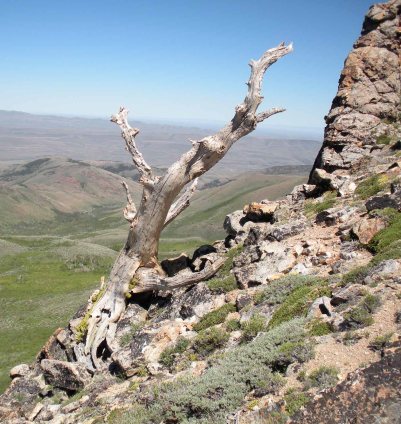Early in the morning, before getting sucked into the e-world, sometimes even before having coffee, I’ve been reading a book called Cancer: The Evolutionary Legacy by a British medical researcher named Mel Greaves. This probably sounds like an astoundingly bad way to start the day, but Greaves’ tone is pretty light, and he doesn’t get into the individual stories of cancer sufferers. It’s a concept book, and an incredibly fascinating one. I’m only making it through a few pages a day, because I’m constantly stopping to digest some point, and turning the margins into snarls of exclamation points, arrows, and scribbled thoughts.
Greaves obviously loves a good analogy, and when he describes metastasis—the establishment of cancer cells in new locations within the body—what comes out, strangely enough, is pure biogeography, and, in particular, long-distance colonization. The malignant cells in their original location (colon, breast, or wherever) are hemmed in by physical boundaries and barriers, like “an overpopulating and localized species of animal” confined to an island, with the surrounding sea cutting off escape. When a few cells manage to break out into the bloodstream or lymphatic circulation, “it is rather like a desperate migrant crossing the China Sea in a fragile vessel.” Most of these cells will not survive the journey, but “given the number that try and the time available, inevitably a few may succeed.”
In other words, the movement of cancer cells is a lot like monkeys crossing the Atlantic or other instances of chance, overseas dispersal, even extending to the idea that a small probability of success for any single attempt can translate to a much higher one given enough time. That quote about “the number that try and the time available” could have come from the paleontologist George Gaylord Simpson writing about overwater dispersal by Cenozoic mammals. Or, for that matter, from Darwin arguing for the natural colonization of oceanic islands.

Figure drawing: Edward Burne-Jones. Map: Ktrinko—own work, CC0, https://commons.wikimedia.org/w/index.php?curid=17169364
The analogy doesn’t stop there, though; in fact, the detailed parallels pile up almost to the point of absurdity. Thus, once a cancer clone makes it to a new location, it is more likely to thrive “in a similar environment or ecosystem to that from which it came—one part of the bladder to the other, skin to skin.” So the successfully colonizing cancer cell is like, say, a shrub from a tropical rainforest that, after dispersing, gains a foothold because it happens to find itself in another tropical rainforest.
Continuing on, some types of cancer cells are better migrants than others, just as ducks and rats are more likely overseas colonists than salamanders and kangaroos. Numbers at the source location are important in both instances—of cancer cells in the one case and of individual organisms in the other. Access to thoroughfares can be critical—cancer cells multiplying next to a large blood vessel are like monkeys living by a river that might wash them down to the sea. And lymph nodes can act as way stations for migrating cancer cells, the equivalent of stepping-stone islands for migrating species.
Greaves’ analogy makes it clear that metastasis is, at its core, a random process, but with the probabilities heavily influenced by various factors. The randomness of it—chance cell movement, like chance dispersal—gives some insight into the fact that two people could develop the same kind of cancer simultaneously, yet, in one, the disease might spread almost immediately whereas, in the other, it might take years to metastasize. Meanwhile, the influencing factors, such as access to many blood vessels and lymph nodes, make sense of why some kinds of cancer often persist for years without spreading, while others can be expected to metastasize very quickly.
Following up on these thoughts, I did a quick search in the Web of Science for mathematical models of metastasis. None of the studies mentioned overseas dispersal or rafts of vegetation, but they did give me some reason to tweak the biogeographic analogy to more closely match the disease situation. It appears that, for at least some kinds of cancer, the initial and subsequent tumors might interact with each other beyond the original one-way colonizations. In particular, the tumors within a person seem to receive new “seeds”—colonizing cancer cells—from one another, and the re-seeding influences their growth. This makes me think that monkeys rafting across the Atlantic, which happened only once as far as anyone knows, is not the best analogy for these cases. The migrating cancer cells are more like Darwin’s finches colonizing and re-colonizing islands in the Galápagos.
Darwin’s evolutionary ideas have been fruitfully translated to all sorts of areas outside of their original domain, including such things as constructing genealogical trees of languages, describing the fates of memes, and creating computer algorithms that solve problems by mimicking natural selection. Close to the topic at hand, many people have recognized that the growth and spread of cancer within the body is a Darwinian process—selection occurring at the level of competition among cells—and that this knowledge might prove useful in developing new treatments.
To end on a vaguely practical note, I wonder if models of chance dispersal—the mathematical embodiment of ideas set forth by Darwin, Simpson, and others—might be applied to the process of metastasis. Could these biogeographic models give us some novel insight into that process, either by introducing new variables or a different kind of analysis? Could they provide something more medically useful than a metaphor?



























